Assessing the Relevancy of Roger's Innovation Adoption Model: A Study
VerifiedAdded on 2022/10/19
|5
|1092
|342
Essay
AI Summary
This essay critically examines the relevancy of Roger's Innovation Adoption Model, also known as the Diffusion of Innovation theory. It outlines the model's core components, including innovation, adopters, communication channels, time, and the social system. The essay details the five stages of adoption: knowledge, persuasion, decision, implementation, and confirmation. It also discusses the factors influencing adoption, such as relative advantage, compatibility, complexity, trialability, and observability. The essay then explores the model's effectiveness in various fields like agriculture, healthcare, and marketing. However, it also highlights the model's limitations, particularly in predicting the adoption of complex, networked information technologies like EDI. The essay concludes that while the model is useful, it needs careful consideration and restructuring for complex technologies and may ignore important predictors of adoption.
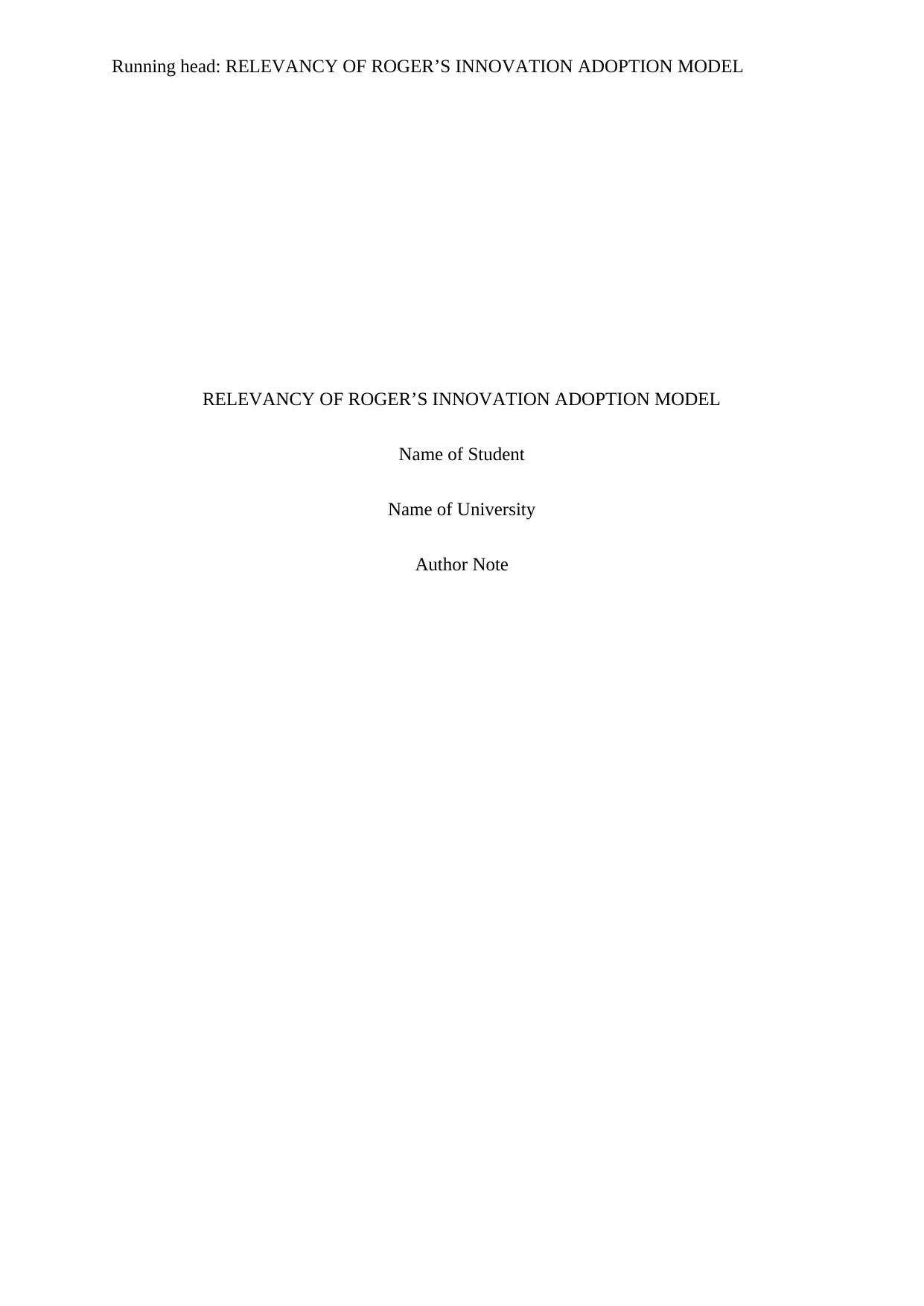
Running head: RELEVANCY OF ROGER’S INNOVATION ADOPTION MODEL
RELEVANCY OF ROGER’S INNOVATION ADOPTION MODEL
Name of Student
Name of University
Author Note
RELEVANCY OF ROGER’S INNOVATION ADOPTION MODEL
Name of Student
Name of University
Author Note
Paraphrase This Document
Need a fresh take? Get an instant paraphrase of this document with our AI Paraphraser
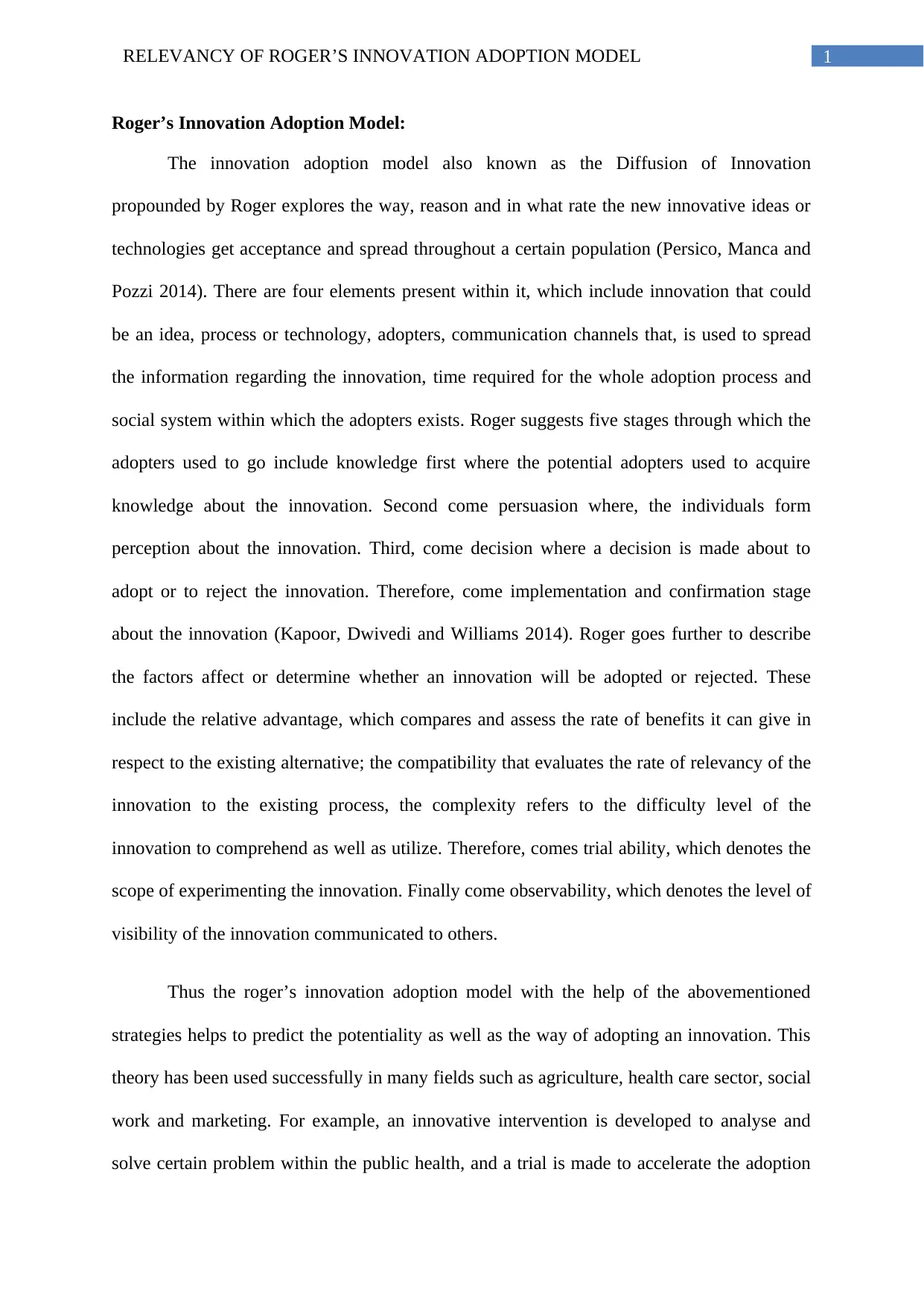
1RELEVANCY OF ROGER’S INNOVATION ADOPTION MODEL
Roger’s Innovation Adoption Model:
The innovation adoption model also known as the Diffusion of Innovation
propounded by Roger explores the way, reason and in what rate the new innovative ideas or
technologies get acceptance and spread throughout a certain population (Persico, Manca and
Pozzi 2014). There are four elements present within it, which include innovation that could
be an idea, process or technology, adopters, communication channels that, is used to spread
the information regarding the innovation, time required for the whole adoption process and
social system within which the adopters exists. Roger suggests five stages through which the
adopters used to go include knowledge first where the potential adopters used to acquire
knowledge about the innovation. Second come persuasion where, the individuals form
perception about the innovation. Third, come decision where a decision is made about to
adopt or to reject the innovation. Therefore, come implementation and confirmation stage
about the innovation (Kapoor, Dwivedi and Williams 2014). Roger goes further to describe
the factors affect or determine whether an innovation will be adopted or rejected. These
include the relative advantage, which compares and assess the rate of benefits it can give in
respect to the existing alternative; the compatibility that evaluates the rate of relevancy of the
innovation to the existing process, the complexity refers to the difficulty level of the
innovation to comprehend as well as utilize. Therefore, comes trial ability, which denotes the
scope of experimenting the innovation. Finally come observability, which denotes the level of
visibility of the innovation communicated to others.
Thus the roger’s innovation adoption model with the help of the abovementioned
strategies helps to predict the potentiality as well as the way of adopting an innovation. This
theory has been used successfully in many fields such as agriculture, health care sector, social
work and marketing. For example, an innovative intervention is developed to analyse and
solve certain problem within the public health, and a trial is made to accelerate the adoption
Roger’s Innovation Adoption Model:
The innovation adoption model also known as the Diffusion of Innovation
propounded by Roger explores the way, reason and in what rate the new innovative ideas or
technologies get acceptance and spread throughout a certain population (Persico, Manca and
Pozzi 2014). There are four elements present within it, which include innovation that could
be an idea, process or technology, adopters, communication channels that, is used to spread
the information regarding the innovation, time required for the whole adoption process and
social system within which the adopters exists. Roger suggests five stages through which the
adopters used to go include knowledge first where the potential adopters used to acquire
knowledge about the innovation. Second come persuasion where, the individuals form
perception about the innovation. Third, come decision where a decision is made about to
adopt or to reject the innovation. Therefore, come implementation and confirmation stage
about the innovation (Kapoor, Dwivedi and Williams 2014). Roger goes further to describe
the factors affect or determine whether an innovation will be adopted or rejected. These
include the relative advantage, which compares and assess the rate of benefits it can give in
respect to the existing alternative; the compatibility that evaluates the rate of relevancy of the
innovation to the existing process, the complexity refers to the difficulty level of the
innovation to comprehend as well as utilize. Therefore, comes trial ability, which denotes the
scope of experimenting the innovation. Finally come observability, which denotes the level of
visibility of the innovation communicated to others.
Thus the roger’s innovation adoption model with the help of the abovementioned
strategies helps to predict the potentiality as well as the way of adopting an innovation. This
theory has been used successfully in many fields such as agriculture, health care sector, social
work and marketing. For example, an innovative intervention is developed to analyse and
solve certain problem within the public health, and a trial is made to accelerate the adoption
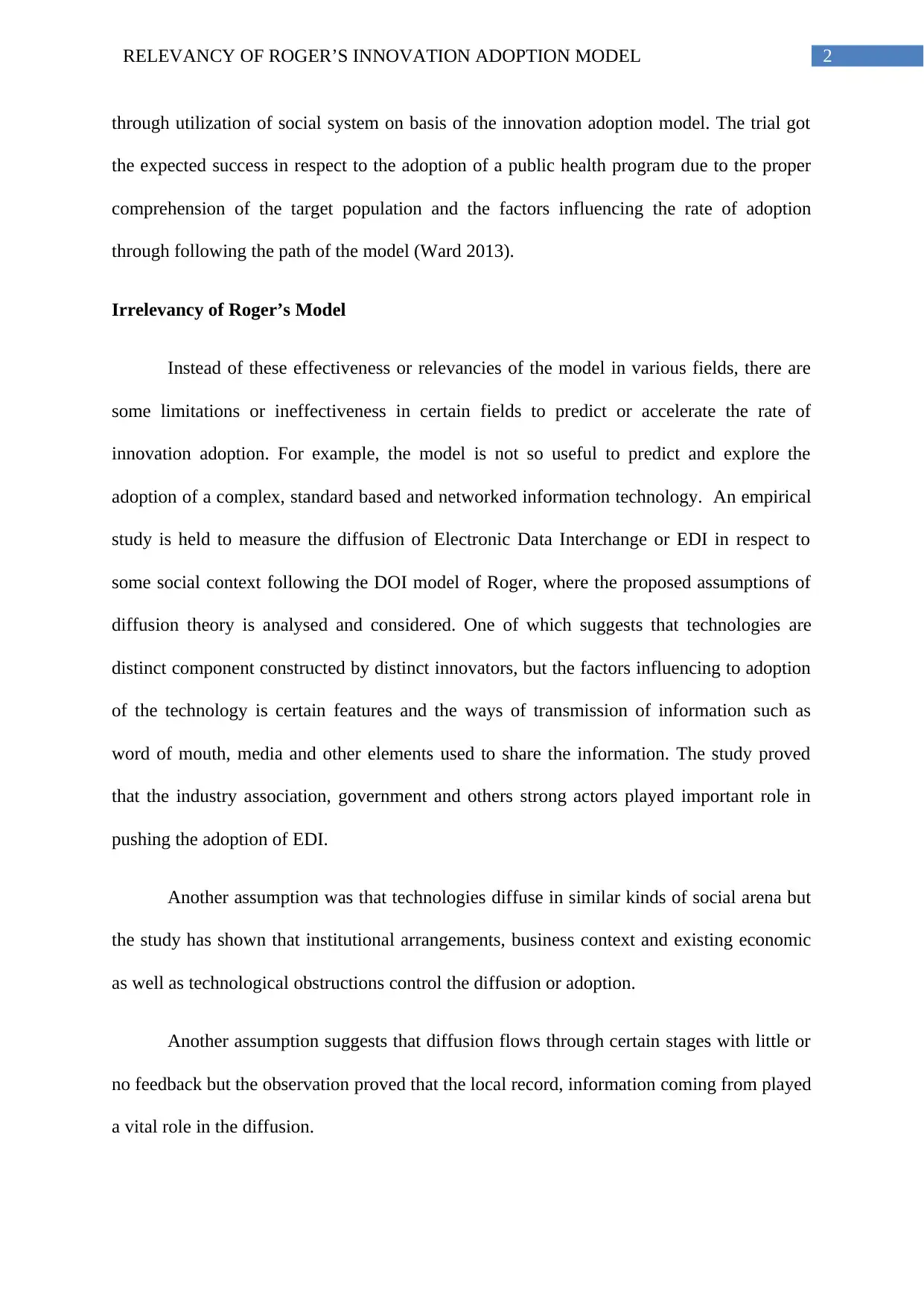
2RELEVANCY OF ROGER’S INNOVATION ADOPTION MODEL
through utilization of social system on basis of the innovation adoption model. The trial got
the expected success in respect to the adoption of a public health program due to the proper
comprehension of the target population and the factors influencing the rate of adoption
through following the path of the model (Ward 2013).
Irrelevancy of Roger’s Model
Instead of these effectiveness or relevancies of the model in various fields, there are
some limitations or ineffectiveness in certain fields to predict or accelerate the rate of
innovation adoption. For example, the model is not so useful to predict and explore the
adoption of a complex, standard based and networked information technology. An empirical
study is held to measure the diffusion of Electronic Data Interchange or EDI in respect to
some social context following the DOI model of Roger, where the proposed assumptions of
diffusion theory is analysed and considered. One of which suggests that technologies are
distinct component constructed by distinct innovators, but the factors influencing to adoption
of the technology is certain features and the ways of transmission of information such as
word of mouth, media and other elements used to share the information. The study proved
that the industry association, government and others strong actors played important role in
pushing the adoption of EDI.
Another assumption was that technologies diffuse in similar kinds of social arena but
the study has shown that institutional arrangements, business context and existing economic
as well as technological obstructions control the diffusion or adoption.
Another assumption suggests that diffusion flows through certain stages with little or
no feedback but the observation proved that the local record, information coming from played
a vital role in the diffusion.
through utilization of social system on basis of the innovation adoption model. The trial got
the expected success in respect to the adoption of a public health program due to the proper
comprehension of the target population and the factors influencing the rate of adoption
through following the path of the model (Ward 2013).
Irrelevancy of Roger’s Model
Instead of these effectiveness or relevancies of the model in various fields, there are
some limitations or ineffectiveness in certain fields to predict or accelerate the rate of
innovation adoption. For example, the model is not so useful to predict and explore the
adoption of a complex, standard based and networked information technology. An empirical
study is held to measure the diffusion of Electronic Data Interchange or EDI in respect to
some social context following the DOI model of Roger, where the proposed assumptions of
diffusion theory is analysed and considered. One of which suggests that technologies are
distinct component constructed by distinct innovators, but the factors influencing to adoption
of the technology is certain features and the ways of transmission of information such as
word of mouth, media and other elements used to share the information. The study proved
that the industry association, government and others strong actors played important role in
pushing the adoption of EDI.
Another assumption was that technologies diffuse in similar kinds of social arena but
the study has shown that institutional arrangements, business context and existing economic
as well as technological obstructions control the diffusion or adoption.
Another assumption suggests that diffusion flows through certain stages with little or
no feedback but the observation proved that the local record, information coming from played
a vital role in the diffusion.
⊘ This is a preview!⊘
Do you want full access?
Subscribe today to unlock all pages.

Trusted by 1+ million students worldwide
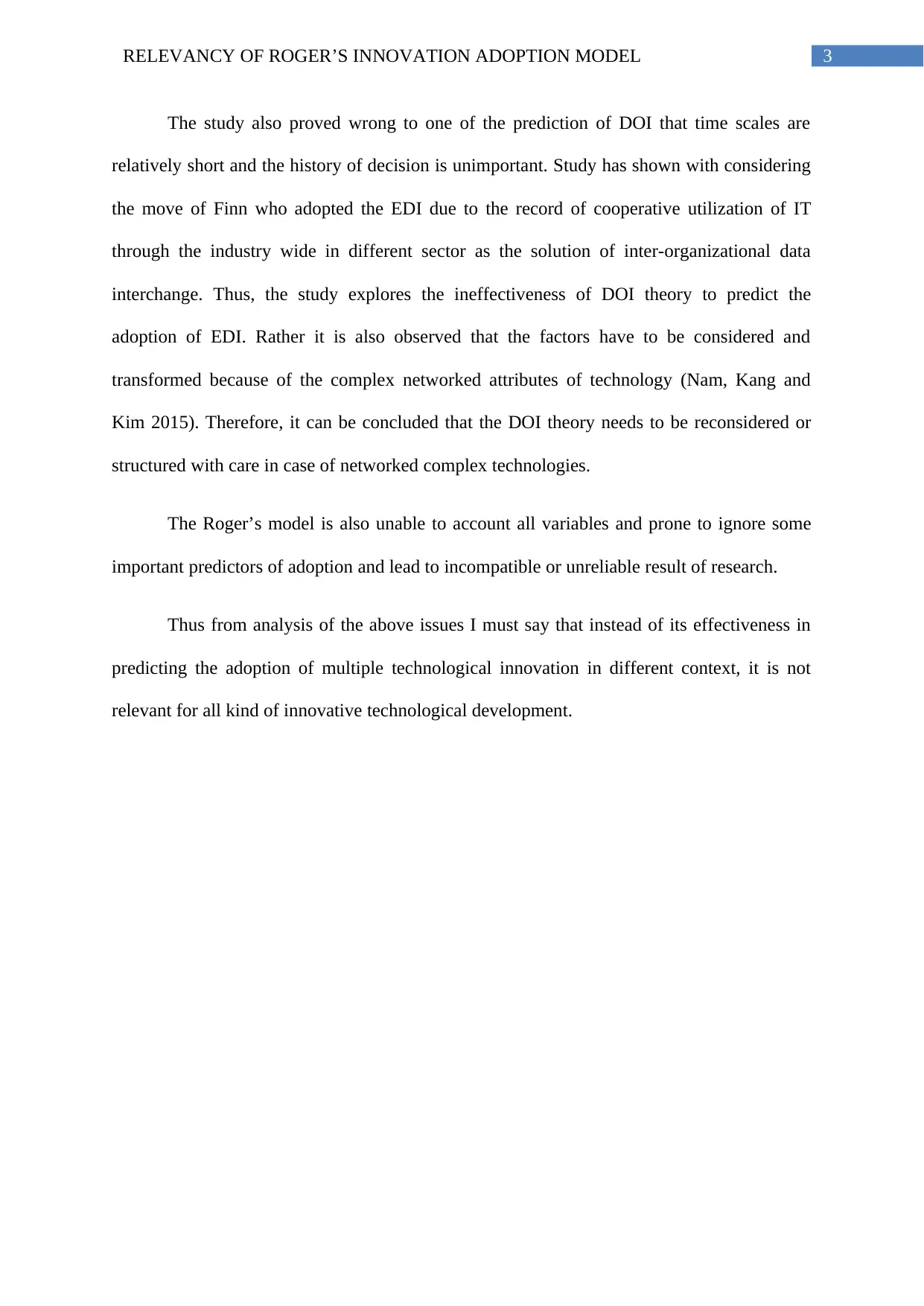
3RELEVANCY OF ROGER’S INNOVATION ADOPTION MODEL
The study also proved wrong to one of the prediction of DOI that time scales are
relatively short and the history of decision is unimportant. Study has shown with considering
the move of Finn who adopted the EDI due to the record of cooperative utilization of IT
through the industry wide in different sector as the solution of inter-organizational data
interchange. Thus, the study explores the ineffectiveness of DOI theory to predict the
adoption of EDI. Rather it is also observed that the factors have to be considered and
transformed because of the complex networked attributes of technology (Nam, Kang and
Kim 2015). Therefore, it can be concluded that the DOI theory needs to be reconsidered or
structured with care in case of networked complex technologies.
The Roger’s model is also unable to account all variables and prone to ignore some
important predictors of adoption and lead to incompatible or unreliable result of research.
Thus from analysis of the above issues I must say that instead of its effectiveness in
predicting the adoption of multiple technological innovation in different context, it is not
relevant for all kind of innovative technological development.
The study also proved wrong to one of the prediction of DOI that time scales are
relatively short and the history of decision is unimportant. Study has shown with considering
the move of Finn who adopted the EDI due to the record of cooperative utilization of IT
through the industry wide in different sector as the solution of inter-organizational data
interchange. Thus, the study explores the ineffectiveness of DOI theory to predict the
adoption of EDI. Rather it is also observed that the factors have to be considered and
transformed because of the complex networked attributes of technology (Nam, Kang and
Kim 2015). Therefore, it can be concluded that the DOI theory needs to be reconsidered or
structured with care in case of networked complex technologies.
The Roger’s model is also unable to account all variables and prone to ignore some
important predictors of adoption and lead to incompatible or unreliable result of research.
Thus from analysis of the above issues I must say that instead of its effectiveness in
predicting the adoption of multiple technological innovation in different context, it is not
relevant for all kind of innovative technological development.
Paraphrase This Document
Need a fresh take? Get an instant paraphrase of this document with our AI Paraphraser
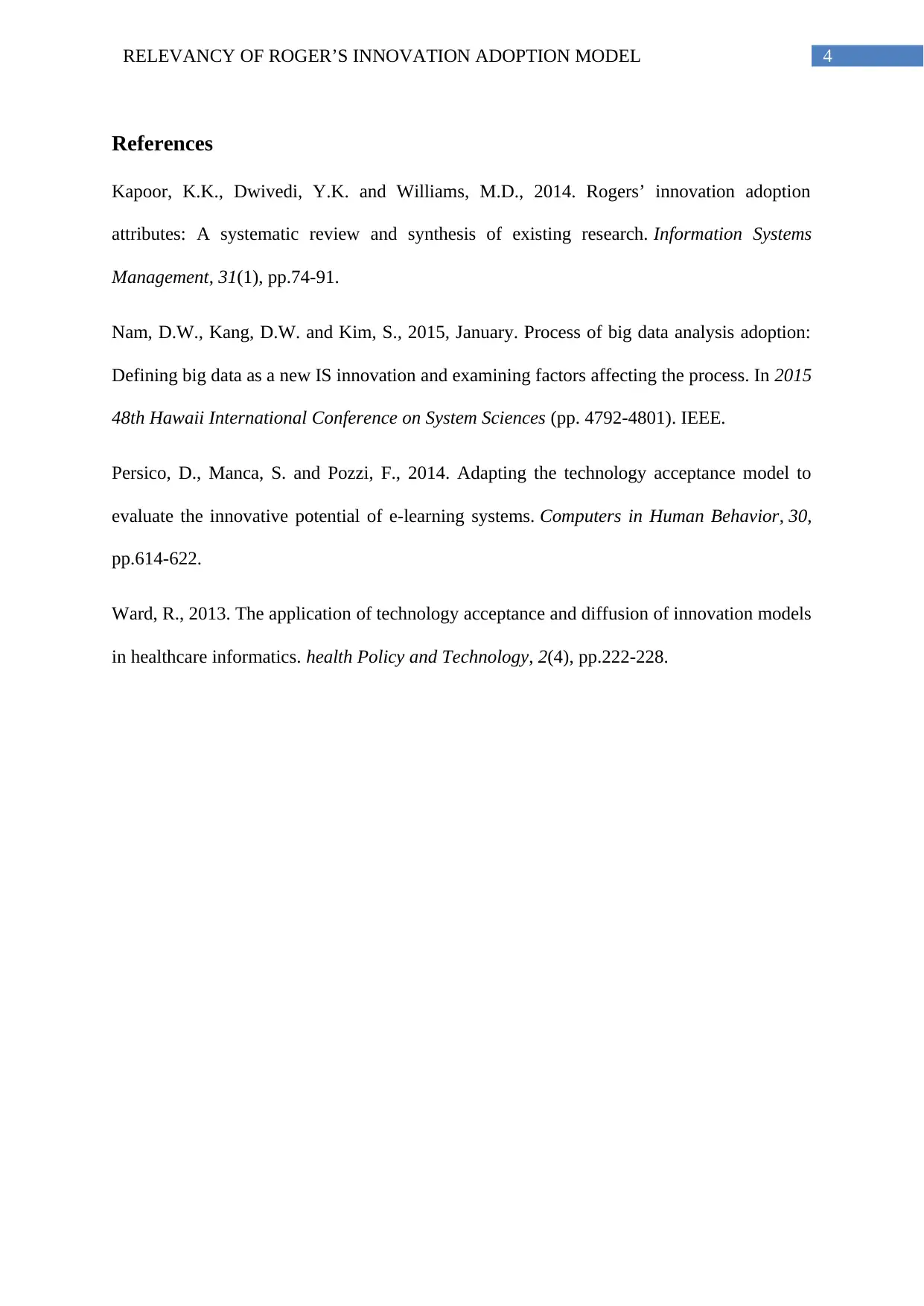
4RELEVANCY OF ROGER’S INNOVATION ADOPTION MODEL
References
Kapoor, K.K., Dwivedi, Y.K. and Williams, M.D., 2014. Rogers’ innovation adoption
attributes: A systematic review and synthesis of existing research. Information Systems
Management, 31(1), pp.74-91.
Nam, D.W., Kang, D.W. and Kim, S., 2015, January. Process of big data analysis adoption:
Defining big data as a new IS innovation and examining factors affecting the process. In 2015
48th Hawaii International Conference on System Sciences (pp. 4792-4801). IEEE.
Persico, D., Manca, S. and Pozzi, F., 2014. Adapting the technology acceptance model to
evaluate the innovative potential of e-learning systems. Computers in Human Behavior, 30,
pp.614-622.
Ward, R., 2013. The application of technology acceptance and diffusion of innovation models
in healthcare informatics. health Policy and Technology, 2(4), pp.222-228.
References
Kapoor, K.K., Dwivedi, Y.K. and Williams, M.D., 2014. Rogers’ innovation adoption
attributes: A systematic review and synthesis of existing research. Information Systems
Management, 31(1), pp.74-91.
Nam, D.W., Kang, D.W. and Kim, S., 2015, January. Process of big data analysis adoption:
Defining big data as a new IS innovation and examining factors affecting the process. In 2015
48th Hawaii International Conference on System Sciences (pp. 4792-4801). IEEE.
Persico, D., Manca, S. and Pozzi, F., 2014. Adapting the technology acceptance model to
evaluate the innovative potential of e-learning systems. Computers in Human Behavior, 30,
pp.614-622.
Ward, R., 2013. The application of technology acceptance and diffusion of innovation models
in healthcare informatics. health Policy and Technology, 2(4), pp.222-228.
1 out of 5
Related Documents
Your All-in-One AI-Powered Toolkit for Academic Success.
+13062052269
info@desklib.com
Available 24*7 on WhatsApp / Email
![[object Object]](/_next/static/media/star-bottom.7253800d.svg)
Unlock your academic potential
Copyright © 2020–2025 A2Z Services. All Rights Reserved. Developed and managed by ZUCOL.




